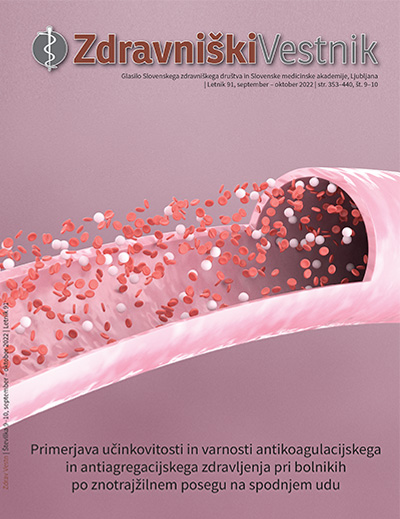The importance of magnetic resonance arthrography in the diagnosis of shoulder joint instability
DOI:
https://doi.org/10.6016/ZdravVestn.3233Keywords:
glenohumeral joint, shoulder instability, magnetic resonance arthrography, contrast agentAbstract
The shoulder joint is the most mobile joint in the human body due to its structure, but for the same reason, it is also the most unstable joint. With complete or incomplete shoulder dislocations, the joint stabilizers are damaged. That makes the joint even more unstable, which leads to a vicious circle. Shoulder joint instability is often a problem for young people, especially athletes, so an accurate diagnosis of the trauma of small intra-articular structures is crucial for treating shoulder instability. The most established diagnostic method for shoulder instability is MR arthrography under the supervision of fluoroscopy. In recent years, with the rapid development of ultrasound technology, significant progress has been made, especially in the quality of high-frequency linear probes, which allows us to display small soft tissue structures accurately. The latter enabled the development of minimally invasive procedures, especially in the musculoskeletal organ system, in which precision and transparency are indispensable, and which include arthrography.
Downloads
References
1. Beltran J, Rosenberg ZS, Chandnani VP, Cuomo F, Beltran S, Rokito A. Glenohumeral instability: evaluation with MR arthrography. Radiographics. 1997;17(3):657-73.
DOI: 10.1148/radiographics.17.3.9153704
PMID: 9153704
2. Kadi R, Milants A, Shahabpour M. Shoulder anatomy and normal variants. J Belg Soc Radiol. 2017;101(S2):3.
DOI: 10.5334/jbr-btr.1467
PMID: 30498801
3. Farber JM, Buckwalter KA. Sports-related injuries of the shoulder: instability. Radiol Clin North Am. 2002;40(2):235-49.
DOI: 10.1016/S0033-8389(02)00002-7
PMID: 12118823
4. Peterson JJ, Bancroft LW. History of arthrography. Radiol Clin North Am. 2009;47(3):373-86.
DOI: 10.1016/j.rcl.2008.12.001
PMID: 19361665
5. Terry GC, Chopp TM. Functional anatomy of the shoulder. J Athl Train. 2000;35(3):248-55.
PMID: 16558636
6. Sebro R, Oliveira A, Palmer WE. MR arthrography of the shoulder: technical update and clinical applications. Semin Musculoskelet Radiol. 2014;18(4):352-64.
DOI: 10.1055/s-0034-1384825
PMID: 25184391
7. Dépelteau H, Bureau NJ, Cardinal E, Aubin B, Brassard P. Arthrography of the shoulder: a simple fluoroscopically guided approach for targeting the rotator cuff interval. AJR Am J Roentgenol. 2004;182(2):329-32.
DOI: 10.2214/ajr.182.2.1820329
PMID: 14736656
8. Ogul H, Bayraktutan U, Ozgokce M, Tuncer K, Yuce I, Yalcin A, et al. Ultrasound-guided shoulder MR arthrography: comparison of rotator interval and posterior approach. Clin Imaging. 2014;38(1):11-7.
DOI: 10.1016/j.clinimag.2013.07.006
PMID: 24119385
9. Perdikakis E, Drakonaki E, Maris T, Karantanas A. MR arthrography of the shoulder: tolerance evaluation of four different injection techniques. Skeletal Radiol. 2013;42(1):99-105.
DOI: 10.1007/s00256-012-1526-y
PMID: 23064511
10. Grasso RF, Faiella E, Cimini P, Cazzato RL, Luppi G, Martina F, et al. Direct magnetic resonance (MR) shoulder arthrography: posterior approach under ultrasonographic guidance and abduction (PAUGA). Radiol Med (Torino). 2013;118(5):806-15.
DOI: 10.1007/s11547-012-0879-6
PMID: 22986699
11. McCarthy CL. Glenohumeral instability. Imaging. 2014;23(1):20110084.
DOI: 10.1259/img.20110084
12. Ruiz Santiago F, Martínez Martínez A, Tomás Muñoz P, Pozo Sánchez J, Zarza Pérez A. Imaging of shoulder instability. Quant Imaging Med Surg. 2017;7(4):422-33.
DOI: 10.21037/qims.2017.08.05
PMID: 28932699
13. Schneider R, Ghelman B, Kaye JJ. A simplified injection technique for shoulder arthrography. Radiology. 1975;114(3):738-9.
DOI: 10.1148/114.3.738b
PMID: 1118584
14. Farmer KD, Hughes PM. MR arthrography of the shoulder: fluoroscopically guided technique using a posterior approach. AJR Am J Roentgenol. 2002;178(2):433-4.
DOI: 10.2214/ajr.178.2.1780433
PMID: 11804911
15. Rutten MJ, Collins JM, Maresch BJ, Smeets JH, Janssen CM, Kiemeney LA, et al. Glenohumeral joint injection: a comparative study of ultrasound and fluoroscopically guided techniques before MR arthrography. Eur Radiol. 2009;19(3):722-30.
DOI: 10.1007/s00330-008-1200-x
PMID: 18958474
16. Salapura V, Mitrovič G, Čavka M. Ultrazvučni nadzor posteriornog pristupa kod MR artrografija ramena. Lijec Vjesn. 2017;139:268-72.
17. Ji JY. A Comparison between the Anterior and PosteriorApproach to US-guided Shoulder Articular Injections for MR Arthrography. J Korean Radiol Soc. 2008;59(4):269-73.
DOI: 10.3348/jkrs.2008.59.4.269
18. Messina C, Banfi G, Aliprandi A, Mauri G, Secchi F, Sardanelli F, et al. Ultrasound guidance to perform intra-articular injection of gadolinium-based contrast material for magnetic resonance arthrography as an alternative to fluoroscopy: the time is now. Eur Radiol. 2016;26(5):1221-5.
DOI: 10.1007/s00330-015-3945-3
PMID: 26253260
19. Ng AW, Hung EH, Griffith JF, Tong CS, Cho CC. Comparison of ultrasound versus fluoroscopic guided rotator cuff interval approach for MR arthrography. Clin Imaging. 2013;37(3):548-53.
DOI: 10.1016/j.clinimag.2012.08.002
PMID: 23601770
Downloads
Published
Issue
Section
License

The Author transfers to the Publisher (Slovenian Medical Association) all economic copyrights following form Article 22 of the Slovene Copyright and Related Rights Act (ZASP), including the right of reproduction, the right of distribution, the rental right, the right of public performance, the right of public transmission, the right of public communication by means of phonograms and videograms, the right of public presentation, the right of broadcasting, the right of rebroadcasting, the right of secondary broadcasting, the right of communication to the public, the right of transformation, the right of audiovisual adaptation and all other rights of the author according to ZASP.
The aforementioned rights are transferred non-exclusively, for an unlimited number of editions, for the term of the statutory
The Author can make use of his work himself or transfer subjective rights to others only after 3 months from date of first publishing in the journal Zdravniški vestnik/Slovenian Medical Journal.
The Publisher (Slovenian Medical Association) has the right to transfer the rights of acquired parties without explicit consent of the Author.
The Author consents that the Article be published under the Creative Commons BY-NC 4.0 (attribution-non-commercial) or comparable licence.



